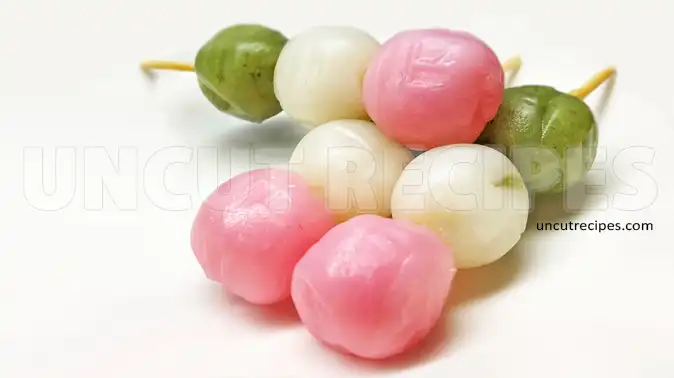Metric:
240gr Mochiko
240gr Tofu
( soft )
120g Sugar
2gr Green Tea Powder
Red Food Coloring
Salted Cherry Flowers
( if available )
Recipes > Japanese Recipes > Japanese Dessert Recipes > Japanese Dango Recipes

TRADITIONAL JAPANESE RECIPE: Hanami Dango is a Japanese sweet Mochi dessert, where 3 different Dango balls, pink, white, and green, are skewered on a stick.
In Japan, the end of March to April is the time of viewing and appreciating cherry blossoms (“hanami”). People go to parks where a lot of cherry trees are and eat and drink under the trees. Dango is eaten year-round, but the different varieties are traditionally eaten in given seasons. Three to five dango are often served on a skewer.
This dessert’s name, Mitarashi, comes from a festival of a famous shrine in the city of Kyoto in western Japan. Mitarashi Dango was thought to be made as an offering for gods at this shrine in the 14th century. Since then, Mitarashi Dango was sold at street venders in shrines in Kyoto and eventually all over Japan. Today it is quite common. You can find it at Japanese sweet shops, of course, and also at supermarkets and convenience stores.
TYPES:
The many different varieties of dango are usually named after the various seasonings served on or with it.
- Anko is commonly made with (sweetened) red bean paste; ingredients other than azuki are used on rare occasions.
- Chadango is green-tea flavored dango.
- Botchan dango has three colors. One is colored by red beans, the second by eggs, and the third by green tea.
- Denpun dango from Hokkaido is made from potato flour and baked with sweet boiled beans.
- Kuri dango is coated in chestnut paste.
- Chichi dango is a slightly sweet, light treat usually eaten as a dessert.
- Hanami Dango also has three colors, and is traditionally made during Sakura-viewing season, hence the name (Hanami means "flower viewing"; hana meaning "flower", and mi meaning "to see").
- Goma uses sesame seeds. It is both sweet and salty.
- Kibi dango is made with millet flour. This variety is prominently featured in the tale of Momotaro, a folkloric Japanese hero, who offers the rounded ball (not skewered) to three talking animals in exchange for their aid in fighting demons.
- Kinako is made with toasted soy flour.
- Kushi dango' is held by a skewer.
- Mitarashi is covered with a syrup made from shouyu (soy sauce), sugar, and starch.
- Nikudango is a type of meatball.
- Teppanyaki on a skewer has a tangy teppanyaki taste.
- Sasa dango is produced and eaten primarily in Niigata Prefecture. Sasa dango has two varieties: onna dango and otoko dango. Onna dango (literally "female dango") is filled with anko, while the otoko dango (literally "male dango") is filled with kinpira. The dango is wrapped in leaves of sasa for the purpose of preservation.
| Skill Level: |
Time: 45 Minutes |
| Price: |
Serves: 2-3 People |
Ingredients:
| Conversions |
Metric:
240gr Mochiko
240gr Tofu
( soft )
120g Sugar
2gr Green Tea Powder
Red Food Coloring
Salted Cherry Flowers
( if available )
Cups:
1.6 cups Mochiko
1 cup Tofu
( soft )
0.5 cup Sugar
1 teaspoon Green Tea Powder
Red Food Coloring
Salted Cherry Flowers
( if available )
Directions:
01 - In a large bowl, mix Mochiko, Tofu, and Sugar until you've formed a smooth dough.
02 - Divide and separate the dough into 3 parts.
03 - Add Green Tea Powder to one part and mix well until becoming a uniform color.
04 - Add a very small amount of Red Food Coloring to another part and mix well.
05 - Leave the last Dough white.
06 - Make table spoon size balls from each Dough.
07 - In a large pot, boil water.
08 - Cook the Dough Balls one color at a time. Once Dango Balls float in the boiling water, cook 2-3 minutes longer and take out from hot water, put on a paper towel, and let cool.
09 - Slide 3 different colored Dango onto each skewer.
Notes:
- If you've found Cherry Flowers, place them on the pink ball when you serve the dango.
- Eat Hanami Dango at room temperature.
| Written by: Uncut Recipes | Disclaimer |

| YOU MIGHT ALSO LIKE: |
| LATEST RECIPES: |
Anita
March 12, 2020 I often buy these at my local japanese market and I love them. I've tried a few recipes but this comes closer to the one I normally buy. Thank you so so so much. |
Kye
February 29, 2020 Loved it. This was really good. My kids devoured them. |
Feith
February 02, 2020 I always thought this was supposed to be eaten hot. I must mistaken them with the other one with the brown sauce. Thanks I'm gonna try doing it. |
Ryley
November 05, 2019 Thank you for this wonderful recipe! I made it and it tasted great! |
Bea
September 27, 2019 My dangos were perfect, texture and density. Deliciouse. But they were ugly ugly. What do you use to roll them? Is it just practice? |
Erica
October 03, 2019 I made this for my daughter but I need more practice! I must admit I cheated a bit with the amount so, my fault. But it tasted great, she loved it. |
Catherine
September 27, 2019 I made it twice. Fist time I put too much water and they came out too sticky. Second time I followed the recipe and they were perfect. Thank you! |

May 01, 2020
Thank you for this recipe.